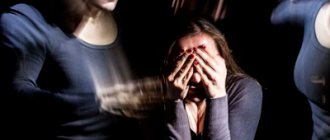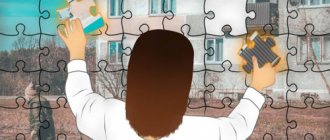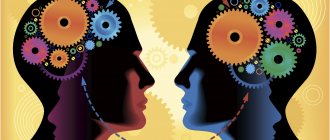Schizophrenic psychosis is an exacerbation of the clinical manifestations of schizophrenia. Most often it has an acute onset. In this case, obvious disruptions in mental functions occur. Patients experience severe delusions, hallucinations, affective disorders, and inappropriate behavior. In this case, patients need emergency care. The Leto Medical Health Center offers people suffering from this pathology treatment in a hospital setting. We help clients with various mental disorders and provide consultations.
How to get to a psychiatric clinic during an exacerbation of the disease
At the first signs of deterioration or the appearance of characteristic complaints, you should immediately contact a specialist. This is usually done by relatives of patients. You should call our medical center. It is listed on the main page of the site, as well as in other subsections.
Describe the essence of the problem to the registrar. If the situation is urgent, the patient will need to be taken to the hospital. You can do this either on your own or with our help. We have the ability to organize transportation of a person in need from their place of residence to the hospital. There will definitely be a medical professional with him.
If the doctor does not identify any contraindications for hospitalization during the initial examination, then the sick person will be immediately admitted to the inpatient department. The cost of staying in a clinical setting will be reported by the call center receptionist. The price depends on many factors.
Reasons for development
It has not yet been fully clarified what disorders in the body lead to the onset of a psychotic state in schizophrenia. Medical theorists still have an acute question about what is the triggering factor for an attack. Existing hypotheses do not fully explain all developing deviations. At the moment, only conditions predisposing to psychosis are identified.
These include:
- Hereditary predisposition.
- Disturbances received in the prenatal period of development, infections suffered during pregnancy, leading to damage to the nervous system.
- Regular use and abuse of psychoactive substances. Synthetic salts and spices cause particular concern. It is against this background that doctors most often encounter the debut manifestations of schizophrenic disorders.
- Impact of pronounced stress factors on the psyche.
- Social reasons. Living in dysfunctional families, moral and mental trauma, character traits, tendency to loneliness, apathy, depression.
Work continues to find the underlying causes of schizophrenia. For now, doctors are focusing on the available data.
General understanding of schizophrenia
Schizophrenia is a mental illness that can have severe forms and is characterized by disorders of the emotional area of a person: disturbances in thought processes, perception, behavior, inability to communicate in society. Most often, schizophrenic symptoms manifest themselves in the age period from 14 to 35 years.
The presence of schizophrenia leads to significant disabilities: the patient does not have the opportunity to receive an education or fully engage in work. It is important to note that this disease cannot be completely cured. However, the severity of its course can be controlled by a psychiatrist. By prescribing the necessary medications in a timely manner, using psychosocial support, the doctor has the opportunity to stop or minimize the manifestation of symptoms.
Symptoms
Diagnosing schizophrenia, especially at an early stage, can be very difficult. This is due to the fact that many of the signs that characterize this disease may indicate other mental disorders. In this case, the doctor sets a period of observation of the patient, during which he conducts a full diagnosis of his condition.
The main symptoms that may indicate the presence of such a pathology are the following:
- auditory, visual or tactile hallucinations appear. The patient begins to see, hear, feel what is not happening in reality;
- delusional states - the patient builds false beliefs for himself that are not shared by others. At the same time, schizophrenics are almost always very suspicious and distrustful of people;
- behavior takes on the features of inappropriate - the patient is disorganized, may forget about the rules of hygiene, appearance, and normal physical sensations are dulled. This may be accompanied by aimless walking, muttering, etc. The mood may change dramatically;
- speech becomes slurred and incoherent. A schizophrenic often independently invents his own words (sentences), giving them a special meaning that is understandable to him alone;
- emotional disturbances are clearly noticeable - apathy, indifference to what is happening, facial expressions, gestures may be absent or, conversely, become too active;
- a person creates his own inner world, withdraws into himself, and practically does not communicate with others.
Diagnostics
Correct, competent diagnosis of mental illness is the beginning of the path to its successful treatment. Due to the fact that it is extremely difficult to determine schizophrenia, especially at the first stage of its development, specialists are as consistent and attentive as possible at this stage.
The doctor regularly communicates with the patient, monitors the dynamics of the development of symptoms, their modification, etc. In addition, the following clinical studies are carried out:
- the patient’s immune status is determined;
- a general and biochemical blood test is performed;
- a hormonal profile is formed;
- additional tests are prescribed to rule out organic brain diseases;
- a general therapeutic and neurological examination is carried out;
- a rapid test is being compiled to determine schizophrenia.
In psychiatric practice, special diagnostic criteria are also known. The presence of at least one of them, and observation of it for 30 days, provides grounds for a more in-depth diagnosis of the disease. Among these criteria are:
- the presence of hallucinations (visions);
- delusions of perception (erroneous judgments about something, paranoia);
- echo of thoughts (voices in the patient’s head);
- associativity (a person avoids communication).
Causes of the disease, its prevention and treatment
Studies of schizophrenia as a mental illness have not found a single factor that could provoke its occurrence. Scientists have come to the conclusion that this mental disorder can occur when the body is exposed to various factors: genetic predisposition, psychosocial circumstances, physical and psychological exhaustion of a person, etc.
Preventive methods to prevent the occurrence of schizophrenia are especially necessary if a person has “blood” relatives with this disease. Prevention consists of regular counseling, testing and, if necessary, supportive care.
Treatment for schizophrenia can be outpatient or inpatient. The second treatment option is necessary in case of acute attacks of the disease, frequent and prolonged relapses. Patients, depending on the severity of the disease, are prescribed antipsychotic drugs of different categories. They are determined exclusively by a specialist after examining the patient.
Diagnostics
In our medical center, special attention is paid to client examination. Establishing an accurate diagnosis in psychiatry is important not only for the preparation of correct therapy, but also for social aspects. A number of diseases may pose a professional limitation, so no mistakes are allowed during diagnostic procedures.
The diagnosis includes:
Collection of complete anamnestic data. The onset of painful manifestations, their dynamics, and the presence of light gaps must be taken into account. Doctors obtain this information from the words of patients or relatives, as well as from available medical documents and studies.- Client inspection. The psychiatrist assesses the status of the functions of internal organs and the nervous system. Particular attention is paid to examining the psyche for the presence of disturbances of consciousness, delusional statements, illusory and hallucinatory visions.
- Research of laboratory tests. Patients must have their blood and urine collected to obtain general clinical and biochemical parameters.
- Taking an electrocardiogram.
The diagnostic process continues throughout the entire period of patients’ stay in the clinic. If necessary, adjustments and additions are subsequently made to the main diagnosis.
Causes of schizophrenic psychosis
The causes of the acute manifestation of the disease - schizophrenic psychosis, as well as other variants of the course of this disease have not been sufficiently studied.
Hypothesis of the occurrence of schizophrenic psychosis
The main hypothesis for the occurrence of the disease and the manifestation of an acute schizophrenic state is the idea of a disruption of the metabolic processes of the brain, a disruption of the exchange of specific neurotransmitters, which in turn are transmitters of information from one nerve cell to another.
Schizophrenic psychoses are primarily determined by such a disorder of thinking as delusions, disturbances of perception such as visual (images popping up in the head), auditory (voices inside the head) pseudohallucinations, which completely take over a person’s consciousness and subjugate all his mental activity, also at the moment of psychosis in The patient has no criticism towards the disease at all.
How does schizophrenic type psychosis manifest?
Clients most often come to our medical center in the acute phase of schizoid psychosis. Attacks can be short-term in nature in the form of isolated excesses. Often there are series of exacerbations with light intervals between them. This course is characterized by a gradual deterioration of each subsequent episode. Remissions, on the contrary, are decreasing.
Psychotic symptoms include:
- Isolated or combined hallucinations of visual, auditory, olfactory composition. One of them may dominate the others.
- Varied in content, pronounced delirium.
- Depression with manifestations of detachment from life.
- Emotional affects.
- Pursuit ideas.
- Depersonalization with complete loss of self-identification and identification with animals and even inanimate objects.
- Motor hyperactivity, or stuporous state.
- Lack of possibility of normal thinking, staying in a pseudo-real world.
- Complete immersion into oneself, into the world of one’s own illusions and hallucinations.
Symptoms of psychosis vary widely. They can build up for several days, then plateau and gradually subside. Treatment significantly softens the clinical picture and its intensity. It is very important to start therapy in a timely manner, select the correct dosage of medication, and eliminate factors that provoke and irritate the patient.
Classification
Continuous schizophrenia often begins at an early age.
She is progressing quickly. Without treatment, it leads to disability within 4-5 years, there are no remissions. Patients show an extreme degree of apathy, their speech is monotonous. Hallucinations are predominantly of a fantastic nature. The pathology is characterized by apathetic-abulic symptoms, dementia, and delusional ideas. Malignant juvenile types of the disease are more common in boys. During the period of manifestation, bright lucid catatonia is noted. This is a state of stupor in which consciousness is almost not disturbed. The memory is preserved. Oneiric catatonia occurs with equal frequency - stupor with disturbance (clouding) of consciousness and memory loss.
The paranoid type during the period of exacerbation is characterized by the predominance of delusional ideas of persecution. Occurs more often in women in adulthood. In addition to delusions, there are illusions and hallucinations of a threatening nature. The mood is often optimistic, but during attacks anxiety and depression predominate.
The recurrent type of course (periodic) is characterized by pronounced somatic disorders. Tachycardia, dehydration, and hemorrhage are present. Patients are able to maintain their ability to work, but personality disorders are noticeable. During the development of the disease, long intervals without symptoms are observed. During attacks, symptoms differ in affective overtones (depression or mania). Possible oneiroid stupefaction, catatonia.
Paroxysmal-progressive schizophrenia includes:
- rough progression - clear periods of remission with a complete absence of symptoms;
- medium - during the period of remission, symptoms do not go away completely;
- small - remission intervals do not have clear boundaries.
Personality changes in paroxysmal schizophrenia occur only during exacerbations and attacks. An exacerbation is characterized by acute delirium, insomnia, and severe anxiety. The fear of going crazy prevails.
Schizotypal disorder is a sluggish course of schizophrenia. During exacerbations, inappropriate behavior, isolation, sluggish emotional reactions, and eccentricity predominate. Thinking and speech are unique. Psychopathological symptoms are weak.
Atypical prolonged pubertal seizures
Schizophrenia in the form of an atypical prolonged pubertal attack, often with a benign course. Symptoms: body dysmorphic disorder, asthenia, infantilism of behavior and thinking.
People aged 11 to 23 years are at risk. This type of disease includes crisis manifestations of adolescence, which are distorted and their clarity increases. The stages of pathology are similar to the stages of adolescence:
- Initial manifestations are typical for patients aged 11-15 years. Characteristic traits become sharper, and bipolar affective disorders arise. Characterized by opposition to the surrounding world, an excessive need for self-affirmation. There is a high level of conflict, ideas of an overvalued nature.
- The increase in psychotic symptoms occurs between the ages of 16 and 20 years. Seizures occur, accompanied by onirism - delirium with hallucinations and confused consciousness. Problems with the associative process and ideas of guilt are noticeable. In addition to hallucinations, there are insomnias. At this stage, the person needs hospitalization and immediate initiation of therapy.
- At 20-25 years of age, symptoms become dynamic, and “bright” periods of remission appear. Social and labor adaptation is being restored.
Schizophrenia in the form of an atypical prolonged pubertal attack is formed on the basis of constitutional genetic factors. Primary importance is given to the mechanisms of adolescent maturation. While analyzing the family background of the patients, scientists came to the following conclusion. The family history of persons with atypical schizophrenia includes sluggish and paroxysmal forms of schizophrenia in the parents.
There are 3 types of atypical pubertal seizures. The first type is heboid attacks. They are characterized by exaggeration and modification of the manifestations of the teenage crisis. Volitional and affective disorders predominate. They lead to disregard for generally accepted norms of behavior. Stages of heboid type:
- At the initial stage, patients are from 11 to 15 years old. They experience increased excitability, perverted emotional reactions and desires. The attitude towards the surrounding world is skeptical and cynical. There is a noticeable desire for originality in reasoning. There are no common interests with peers. Dysthymia, dissatisfaction with oneself, predominates. Patients spend their time wandering the streets or idle.
- At 15-17 years old, the second stage of the disease begins. Pubertal disorders are characterized by psychopathic-like symptoms. The patients are rude, inadequate, and there is no motivation for activity. Negativity towards social norms is clearly manifested. Patients are eccentric, hostile towards relatives and strangers. The attacks are accompanied by impulsiveness, unreasonable rage, and aggression. Intellect is relatively preserved, but academic performance is poor. There are affective disorders, delusions, and hallucinations are possible.
- At the third stage (at 17-20 years old), symptoms stabilize and slow down at the second level. The clinical picture is monotonous and does not change against the background of changes in external conditions. There is an independent improvement in the condition without medical intervention. It lasts from 2-3 days to 2-3 weeks. But then it gets worse again.
- At the fourth stage, behavioral disorders are smoothed out, unmotivated hostility towards parents subsides. The stage indicates stable remission.
Starting from stage 2-3, patients with heboid attacks often begin to use psychoactive substances. Such a person is not amenable to correction or drug treatment. When taking psychoactive substances, mental retardation progresses. Teenagers with this pathology mature very slowly. At stage 2-3 of the disease, the process of growing up practically stops.
The second type of atypical schizophrenia is dysmorphophobic and psychasthenic-like disorders. Patients are dominated by the idea of an illusory physical defect in appearance and body structure. General clinical picture:
- asthenia;
- previously unusual indecision, uncertainty;
- problems in socialization;
- constraint in communication;
- tendency to “soul-searching” and reflection;
- derealization, depersonalization.
A large number of phobias and unreasonable fears develop. On the affective side, the bipolar current predominates. A person hides illusory flaws in appearance with clothes and shoes. Fear - hearing condemnation addressed to you. Stages of development by age with symptoms:
- Initial stage - the patient is from 15 to 18 years old. There is anxiety about excess weight. The patient is concerned about the “irregular” shapes of various parts of the body, the presence of birthmarks, etc. Persistent ideas about one's own defects interfere with learning or work. The person becomes withdrawn. He does not visit public places, does not communicate. There is an affective reaction to what is happening, colored by symptoms of hysteria. The presence of verbal illusions and paranoid thoughts about non-existent “bullying” is noted. Expressed hypochondria, a tendency to self-digging, asthenia.
- The second stage (22-23 years) - beliefs about defectiveness are smoothed out, the affective component is less pronounced.
- The third stage (24-26 years) - symptoms include affective disorders and inadequate ways of responding. What remains is isolation, excessive suggestibility, and self-centeredness.
Youthful metaphysical intoxication is a condition characterized by pretentious mental activity. Symptoms: blurred thinking, slipping, reasoning. Patients are “out of touch” with reality, their reasoning is unproductive. Characterized by fantasizing and isolation similar to autism. Other manifestations: fears, depersonalization, emotional scarcity, depression.
Paranoid schizophrenia
Another type of disease is chronic delusional psychosis or paranoid schizophrenia. This is a disorder in which delusions become the leading symptom. Unlike other types of disorder, delusion is not dynamic and stable. Delusional ideas are systematized.
Ideas about persecution and jealousy dominate in thinking. Hypochondria is very noticeable. There are no gross violations of personality traits. The emotional-volitional sphere is characterized by impoverishment. A special place is occupied by delusional psychosis of the dysmorphophobic type. Such patients are falsely convinced of the presence of physical defects that disfigure their appearance.
Pathology often affects young and mature people. Dysmorphophobia is more common in the female sex. Existing methods of therapy are ineffective against persistent delusional beliefs. Medication and psychotherapeutic approaches accomplish the task of reducing affective disorders. Most patients are able to maintain their ability to work, study and work for a long period.
Researchers have described the dynamics of paranoid manifestations. It develops in accordance with 3 directions: “migration, protection, attack” (“pursued pursuers”). The patient tries to escape from recruitment or persecution. At this time, he changes his place of work or residence. But even in a new location he again notices an attacker who wants to harm him. The patient begins to fear health risks and considers precautionary measures. He buys weapons and does not leave the apartment. If there are false beliefs about poisoning, all food in the refrigerator is carefully checked. To protect themselves, patients often turn to the police.
Chronic paranoid psychosis, occurring with phenomena of overvalued delusions, is another type of paranoid schizophrenia. The pathology most often affects adolescents or young adults (up to 21 years of age). The development of psychosis is slow. Highly valuable ideas often manifest themselves in research activities that were previously unusual for humans. These can also be extremely valuable ideas in love and collecting.
The manifestation of the disease is associated with psychogenic trauma, which becomes key among the patient’s experiences. Psychosis is characterized by periods of exacerbation, attenuation and reverse development of delusional beliefs. The “attenuation” stage can last from 3 to 10 years - the affective intensity of delirium decreases. Then the symptoms reverse.
Residual states (residual effects of pathology) do not always occur in paranoid psychosis. Statistics indicate the following. In people suffering from psychosis for more than 20 years, only 22% of cases developed residual conditions.
Special forms
Febrile schizophrenia is a special type of pathology that includes symptoms of severe toxicosis. Symptoms: severe increase in body temperature, oneiric disturbance of consciousness, overexcitation. There is a cycle of exacerbations and remissions. During the period of remission, symptoms completely subside.
Mosaic is another special type of pathology. Symptoms: increased temper, paranoia, a tendency to complain about imaginary problems, inflated self-esteem to the point of delusions of grandeur, a tendency to manipulate, problems with social adaptation. The symptoms are not persistent and varied. The essence of pathology is that a person experiences a “mixing” of different psychotypes. Therefore, specific symptoms are difficult to describe. At one time a person is characterized by aggressiveness and rudeness, at another - curiosity and tolerance.
There is social schizophrenia, in which a person tends to ignore the discrepancy between personal conclusions and actions. The physiology of the brain is not affected. Symptoms are long-lasting and remissions are rare.
Brief description of other types of pathology:
- Regular schizophrenia is a dissociative disorder caused by stress. With pathology, a person’s personality acquires characteristics that are opposite to each other. There are practically no remissions.
- Circular is a pathology that is more common in middle-aged people. Symptoms include manic and depressive phases, combined with hallucinations and delusions. Emotionality is poor.
- Hypochondriacal - excessive concern about one's own health. Unusual, disturbing sensations arise in the body. Neurosis-like symptoms are present.
- Senestopathic - uncomfortable bodily sensations. They can be localized both externally and on internal organs. The sensations arise without external triggers, and no objective causes are found in somatic health problems.
- Autumn schizophrenia is a pathology that worsens in the fall. Symptoms of depression dominate. Remissions occur at other times of the year.
- Resistant - a stable form of the disorder. It cannot be corrected by psychopharmacology. Remission is possible after treatment with two antipsychotic drugs for 5-8 weeks. Exacerbations are frequent.
Treatment
During the interpsychotic period, maintenance pharmacotherapy is carried out by our doctors on an outpatient basis. It is important that patients are promptly shown to a psychiatrist to monitor their condition and correct the medications used. If psychosis of the schizophrenic type develops, hospitalization will be required.
Our clinic uses the following stages of therapy:
- Mitigation of acute psychotic symptoms. To reduce the manifestations of delusions, hallucinations, affectivity,
neuroleptics. Mental health center specialists use medications and doses that have minimal side effects. Medicines are taken until symptoms are completely reduced. Then a maintenance dosage is prescribed. - When the psychostatus is stabilized, behavior correctors, sedatives, sleep and mood normalizers, and general strengthening agents are added to pharmacotherapy.
- Psychotherapy. Psychotherapists constantly work with each patient, selecting the most appropriate methods of psychocorrection.
Before discharge, patients are given relapse-preventing medications. Please note that attempts to cope with this painful status on your own are strictly not recommended. Self-medication can lead to sad and fatal results.
Rehabilitation activities
At our mental health center there is the opportunity to undergo psychophysical rehabilitation. Patients suffering from schizophrenia during periods of remission need psychological support. Our psychologists, using special programs, achieve good results in rehabilitation.
Psychoses of the schizophrenia spectrum are very well corrected by both drug therapy and psychotherapy. Experienced psychotherapists at our Leto clinic help many people return to normal family life, engage in work and other activities.
To avoid the return of painful manifestations, clients should adhere to all medical recommendations. It is important to undergo a consultation examination in a timely manner. Relatives of patients also play an important role. Their correct behavior and compliance with all medical prescriptions in most cases reduces the likelihood of relapse of psychosis to zero.
Contact us for help, call the Leto clinic and receive a free and anonymous consultation. If hospitalization is required, our doctors will do everything necessary to quickly resolve the problem.
Schizoaffective disorder
Another name for this mental disorder is recurrent schizophrenia. This disease is an intermediate form between schizophrenia and bipolar disorder. The peculiarity of schizoaffective personality disorder is that it has symptoms of the two above diseases.
Recurrent schizophrenia is a chronic disease with periods of remission and exacerbations. With properly prescribed therapy, the activation of symptoms can be sluggish, almost unnoticeable, and periods of rest are significantly extended. Therefore, only a qualified psychiatrist can diagnose SAD and prescribe treatment.
Symptoms
The clinical picture of schizoaffective disorder consists of affective manifestations and signs of schizophrenia. Both groups of symptoms are expressed, as a rule, to the same extent, appearing almost simultaneously or alternating with each other. There is a need to dwell on their description in more detail.
Affective symptoms:
- Mania. This is a state of increased activity. At this time, a person feels a surge of vitality, is always in an elevated, even euphoric, mood, and becomes very active. The feeling of imaginary invincibility leads to such accelerated thinking that the brain loses the ability to concentrate. A person loses the connection between his statements, jumping from one topic to another.
- Doctors identify angry mania as a subtype of mania. In this state, the patient becomes aggressive towards others, opposes them, is rude, and rude. This is especially noticeable when affect is combined with delusional ideas (cleanse the world of garbage, save it from aliens, etc.).
- Depression. This condition is accompanied by disturbances in sleep and appetite, and motor activity is significantly reduced, to the point that the patient has neither the strength nor the desire to get out of bed in the morning. The pace of thinking slows down, a person completely gives himself over to melancholy, self-flagellation, and does not see anything positive around him. This condition is dangerous because it is during this period that there is a high risk of suicide for the patient.
- Agitation. A subtype of depression, it is a motor agitation of a paradoxical nature - the patient tries to hide the depressed mood behind chaotic motor, aimless activity.
Schizophrenic symptoms:
- Crazy ideas. This group of symptoms, as a rule, corresponds to the general background of mood. Depressive affect gives rise to ideas of one’s own insignificance and uselessness. An equally dangerous option is when the patient turns his hatred towards his family, friends, and humanity as a whole. Manic affect, on the contrary, exalts the patient in his eyes, makes him perfect, endowed with superhuman abilities. For example, a patient may consider himself the creator of a unique mechanism for transmitting information to other planets, galaxies, etc.
- Hallucinations. They can be auditory, visual, tactile, etc. During an exacerbation, the patient hears voices from nowhere, sees something that is not really happening, tactilely touches invisible objects, people, etc. The situation can be complicated by concomitant catatonic disorders - stupor, the phenomenon of control (I am chosen by the higher brain and can control everything and everyone).










